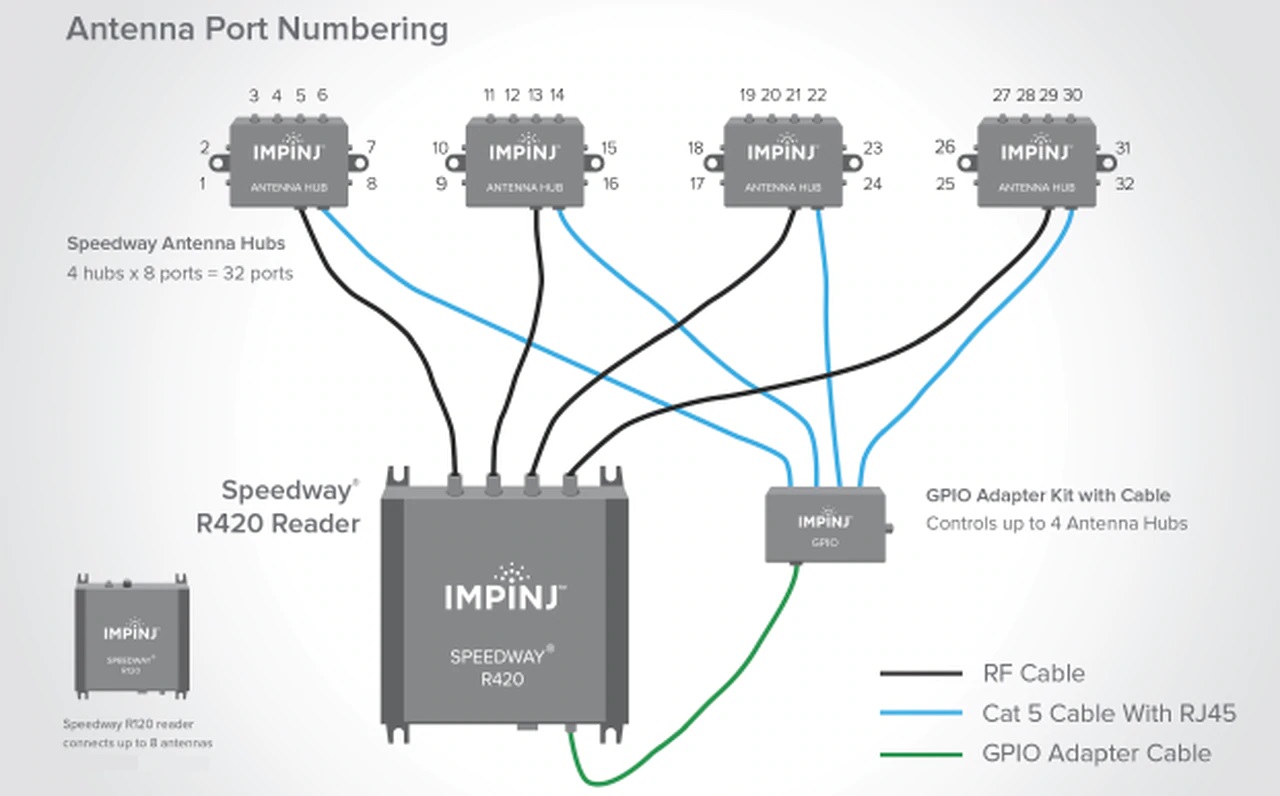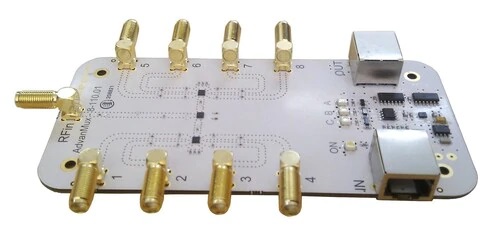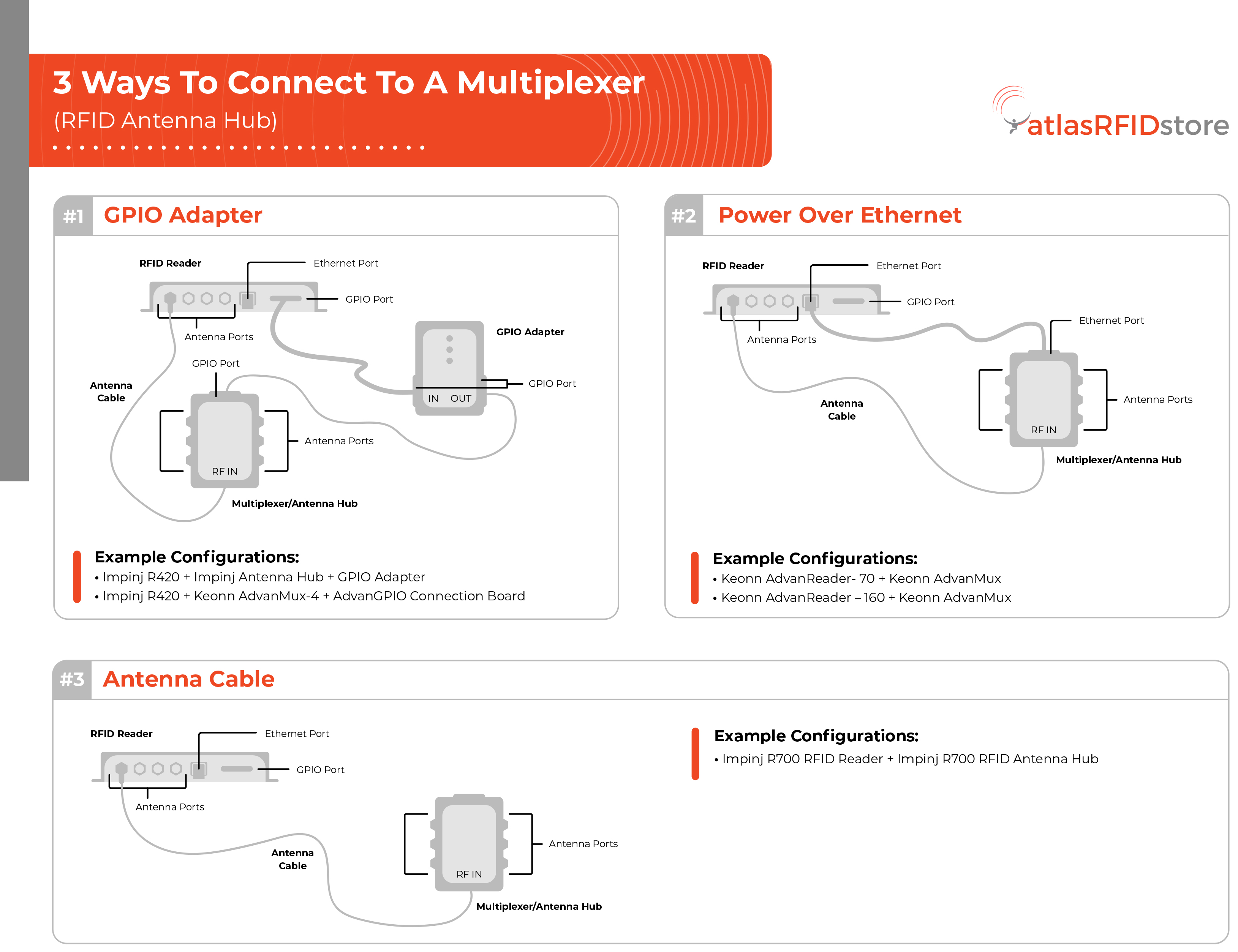Antenna Multiplexers: Save Thousands of Dollars & Learn About Their Core Functionality
In electronics, a multiplexer, also called a ‘mux’ or a ‘data selector’, is a device that selects between several analog or digital input signals and forwards the selected input to a single output line. The selection is directed at a separate set of digital inputs known as select lines.’ *1
In simpler terms, a multiplexer is a device that allows for multiple connections of inputs to one output. In RFID systems, multiplexers are most often called ‘Antenna Hubs’ and can be an integral part of a system to dramatically increase the size of a read area while simultaneously cutting costs. Below is an example system with an RFID Antenna Hub.
Multiplexer Benefits
The prime benefit of RFID multiplexers is the ability to take one antenna port on an RFID Reader and turn it into 4, 8, or 16 additional ports. That means that one antenna port, with the addition of one multiplexer can now connect to 4, 8, or 16 RFID Antennas (depending on the multiplexer). If each antenna port on a typical, 4-port high-performance RFID reader was connected to one multiplexer, a single RFID reader can support 4 times the individual multiplexers capacity. For example – if one Impinj R420 RFID Reader connected to 4 individual Keonn AdvanMux-16 Multiplexers, the system could support 64 individual RFID Antennas.
Because an individual RFID Reader can support so many more RFID Antennas with a multiplexer, these systems typically have a lower install and deployment cost. Let’s check out the difference in cost in the hypothetical situation below where you could save $9,000.
RFID System #1 (Multiplexer) –
Covering a 3,200 sq ft Warehouse, Each Antenna Covers a 10 x 10 Foot Area (100 sq ft)
Equipment:
1 Impinj R700 RFID Reader $1785 + Power Supply $69 ($1854)
4 Impinj R700 Antenna Hubs (Multiplexers) $405 ($1620)
4 x 1 ft RPTNC Male to SMA Male Antenna Cables $32 ($128)
32 MTI MT-262006/TRH/A/K (RHCP) Outdoor RFID Antenna (FCC) $124 ($3968)
4 x 12 ft SMA Male to RPTNC Male Antenna Cables (195) $44 ($176)
8 x 20 ft SMA Male to RPTNC Male Antenna Cables (240) $64 ($512)
8 x 30 ft SMA Male to RPTNC Male Antenna Cables (240) $84 ($672)
8 x 40 ft SMA Male to RPTNC Male Antenna Cables (400) $124 ($992)
4 x 50 ft SMA Male to RPTNC Male Antenna Cables (400) (Custom Cable) $129 ($516)
= $10,438
RFID System #2 (No Multiplexer) -
Covering a 3,200 sq ft Warehouse, Each Antenna Covers a 10 x 10 Foot Area (100 sq ft)
Equipment:
8 Impinj R700 RFID Readers $1785 + Power Supply $69 ($1854 x 8 = $14832)
32 MTI MT-262006/TRH/A/K (RHCP) Outdoor RFID Antenna (FCC) $124 ($3968)
32 x 12 ft RPTNC Male to RPTNC Male Antenna Cables (195) $44 ($1408)
= $20,208
Between those two systems, covering the same read area, that is an $9,770 difference in install/deployment costs.
How do Multiplexers Work?
One multiplexer connects to one antenna port via an RFID Antenna Cable and has multiple antenna ports on it – anywhere from 4 to 16.
The Keonn AdvanMux 8-port Multiplexer shown above, has two sides with four individual antenna ports on each and is connected to the RFID reader via the main “In” port on the left. At each of these ports, an RFID Antenna Cable connects to an RFID Antenna, taking one Antenna Port on an RFID Reader and creating room for 8 RFID Antennas.
Multiplexers are typically powered by the RFID reader, but that isn't the only way.
To see the full size image, click here.
- GPIO Adapter – Most commonly, multiplexers/antenna hubs are powered by connecting to a GPIO adapter, which is connected to an RFID Reader’s GPIO port. The GPIO adapter simply facilitates the connection and provides power to the multiplexers.
- Power over Ethernet (PoE) – In certain Multiplexer/RFID Reader combinations, the multiplexer can be powered by Power over Ethernet (PoE) using an Ethernet cable that connects at the RFID Reader’s Ethernet port and at the Multiplexer’s Ethernet port. Specifically, this can be done using the Keonn AdvanMux Multiplexers with the Keonn AdvanReader-70 or the Keonn AdvanReader-160 readers.
- Antenna Cable – With the release of Impinj’s new R700 RFID Reader, a brand new Antenna Hub called the R700 Antenna Hub was also released. When these two products are used together, the Antenna Hub can be powered through the typical antenna cable connection – which frees up the GPIO port or Ethernet port for additional use.
How do Multiplexers Affect my Overall System?
Multiplexers do affect your overall system in a few different ways:
- Insertion Loss – Insertion loss is the amount of power in dB that is lost when adding a device such a multiplexer between the RFID Reader and RFID Antennas. Generally, insertion loss is between 1 and 1.5 dB, and the amount is not based off the number of additional ports. *2
- Return Loss – The return loss is the amount of power in dB that is lost on the return transmission from the RFID Antenna to the RFID Reader.
- Possible Timing Issues – In typical RFID Systems, the RFID Reader powers one RFID Antenna at a time and slowly cycles through all four antenna ports. With the addition of a multiplexer, the RFID Reader STILL only powers one RFID Antenna at a time, but now there are many more antennas - which can lead to potential timing issues if the RFID application is time-sensitive, like RFID Race Timing. One good aspect is that most RFID Readers allow the user to manually set the amount of time it powers each antenna, anywhere between 25 milliseconds to around 800 milliseconds per antenna.
Are There Differences Between Multiplexers?
Yes, Multiplexers do slightly vary depending on a few factors.
- Antenna Ports – There are a variety of options of antenna ports available on different multiplexers/antenna hubs. The most common options are 4-port units, 8-port units, and 16-port units.
- Power Options – There are three ways to power a multiplexer depending on the exact device and configuration - GPIO adapter, PoE, or using an antenna cable.
- Compatibility – Not every single multiplexer can work with every single RFID Reader or RFID system configuration. Before purchasing a multiplexer, read the data sheet or reach out to the reseller or manufacturer to determine if it can be used with your RFID system.
Conclusion
For more information on Multiplexers, or RFID Antenna Hubs – or anything RFID, comment below or contact us!
To learn more about GPIO Ports and Devices - checkout the article below.
References:
*2 –
https://www.times-7.com/blog/2018/06/24/multiplexer-vs-power-divider/



